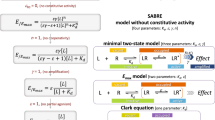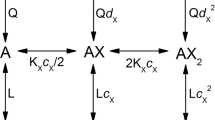Abstract
Most proteins are insensitive to the presence of anaesthetics at concentrations which induce general anaesthesia, while some are inhibited by certain agents but not others1. Here we show that, over a 100,000-fold range of potencies, the activity of a pure soluble protein (firefly luciferase) can be inhibited by 50% at anaesthetic concentrations which are essentially identical to those which anaesthetize animals. This identity holds for inhalational agents (such as halothane, methoxyflurane and chloroform), aliphatic and aromatic alcohols, ketones, ethers and alkanes. This finding is all the more striking in view of the fact that the inhibition is shown to be competitive in nature, with anaesthetic molecules competing with substrate (luciferin) molecules for binding to the protein. We show that the anaesthetic-binding site can accommodate only one large, but more than one small, anaesthetic molecule. The obvious mechanism suggested by our results is that general anaesthetics, despite their chemical and structural diversity, act by competing with endogenous ligands for binding to specific receptors.
This is a preview of subscription content, access via your institution
Access options
Subscribe to this journal
Receive 51 print issues and online access
$199.00 per year
only $3.90 per issue
Buy this article
- Purchase on Springer Link
- Instant access to full article PDF
Prices may be subject to local taxes which are calculated during checkout
Similar content being viewed by others
References
Franks, N. P. & Lieb, W. R. Nature 300, 487–493 (1982).
Halsey, M. J. & Smith, E. B. Nature 227, 1363–1365 (1970).
White, D. C. & Dundas, C. R. Nature 226, 456–458 (1970).
Middleton, A. J. & Smith, E. B. Proc. R. Soc. B193, 159–171 (1976).
Middleton, A. J. & Smith, E. B. Proc. R. Soc. B193, 173–190 (1976).
Ueda, I. & Kamaya, H. Anesthesiology 38, 425–436 (1973).
Adey, G., Wardley-Smith, B. & White, D. Life Sci. 17, 1849–1854 (1976).
Branchini, B. R., Marschner, T. M. & Montemurro, A. M. Analyt. Biochem. 104, 386–396 (1980).
DeLuca, M. & McElroy, W. D. Biochemistry 13, 921–925 (1974).
Wishnia, A. & Pinder, T. W. Biochemistry 5, 1534–1542 (1966).
Robillard, K. A. & Wishnia, A. Biochemistry 11, 3835–3840 (1972).
DeLuca, M. Biochemistry 8, 160–166 (1969).
Denburg, J. L., Lee, R. T. & McElroy, W. D. Archs Biochem. Biophys. 134, 381–394 (1969).
Franks, N. P. & Lieb, W. R. Nature 274, 339–342 (1978).
Seeman, P. Pharmac. Rev. 24, 583–655 (1972).
LaBella, F. S. Perspect. Biol. Med. 25, 322–331 (1982).
Richards, C. D. et al. Nature 276, 775–779 (1978).
Steward, A., Allott, P. R., Cowles, A. L. & Mapleson, W. W. Br. J. Anaesth. 45, 282–293 (1973).
Miller, K. W. & Smith, E. B. in A Guide to Molecular Pharmacology-Toxicology Vol. 1 (ed. Featherstone, R. M.) 427–475 (Dekker, New York, 1973).
Brink, F. & Posternak, J. M. J. cell. comp. Physiol. 32, 211–233 (1948).
Miller, K. W., Paton, W. D. M., Smith, R. A. & Smith, E. B. Molec. Pharmac. 9, 131–143 (1973).
Kita, Y., Bennett, L. J. & Miller, K. W. Biochim. biophys. Acta 647, 130–139 (1981).
Cherkin, A. & Catchpool, J. F. Science 144, 1460–1462 (1964).
Abraham, M. H. J. Am. chem. Soc. 104, 2085–2094 (1982).
Coraish-Bowden, A. Fundamentals of Enzyme Kinetics (Butterworths, London, 1979).
Author information
Authors and Affiliations
Rights and permissions
About this article
Cite this article
Franks, N., Lieb, W. Do general anaesthetics act by competitive binding to specific receptors?. Nature 310, 599–601 (1984). https://doi.org/10.1038/310599a0
Received:
Accepted:
Issue Date:
DOI: https://doi.org/10.1038/310599a0
This article is cited by
-
Promiscuous interaction of titanium dioxide nanoparticles leads to alterations in structural stability and interferes with luciferase folding
Journal of Nanoparticle Research (2023)
-
High-pressure crystallography shows noble gas intervention into protein-lipid interaction and suggests a model for anaesthetic action
Communications Biology (2022)
-
Radical pairs may play a role in microtubule reorganization
Scientific Reports (2022)
-
Serotonin and beyond—a tribute to Manfred Göthert (1939-2019)
Naunyn-Schmiedeberg's Archives of Pharmacology (2021)
-
Time rescaling reproduces EEG behavior during transition from propofol anesthesia-induced unconsciousness to consciousness
Scientific Reports (2018)
Comments
By submitting a comment you agree to abide by our Terms and Community Guidelines. If you find something abusive or that does not comply with our terms or guidelines please flag it as inappropriate.



